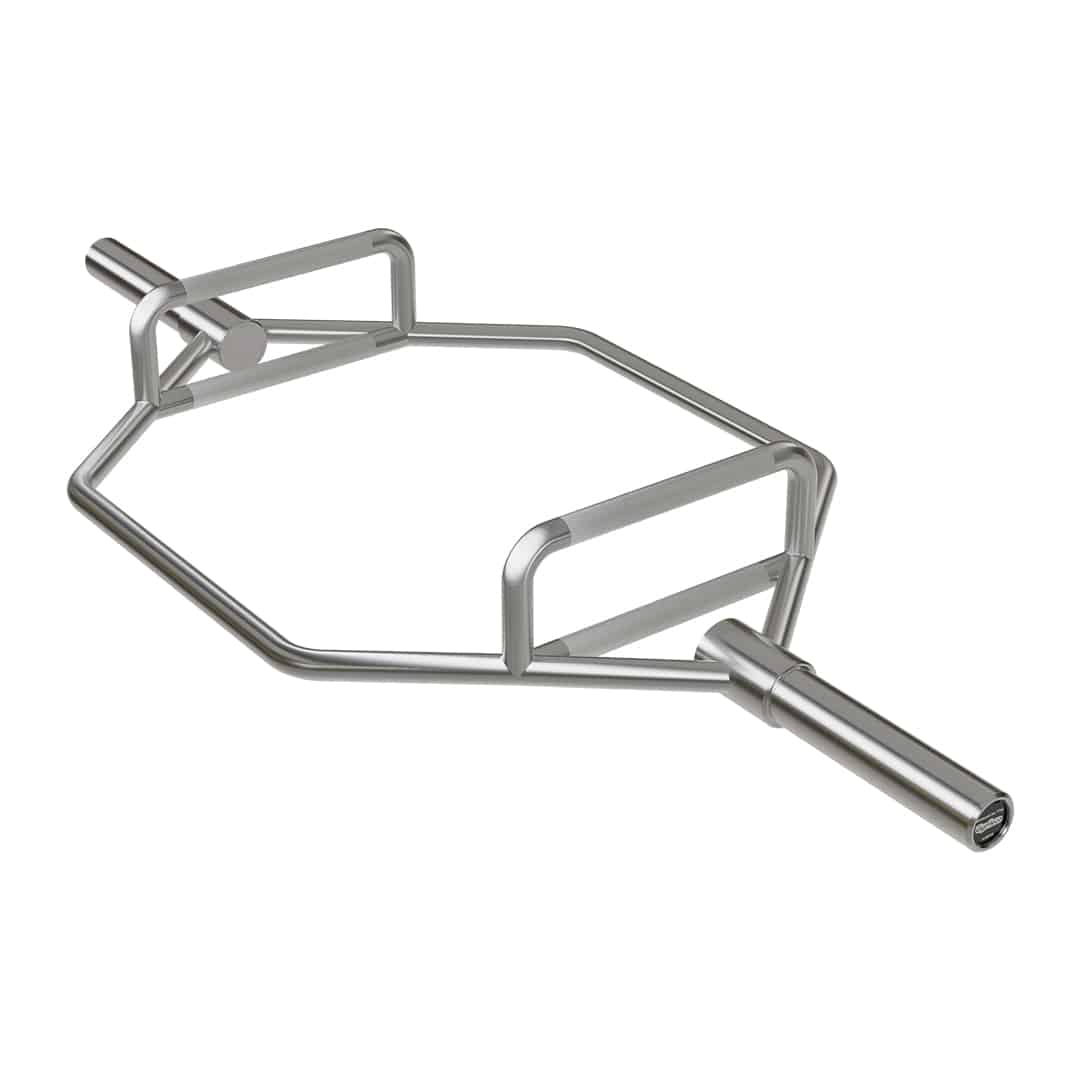Have you been wanting to take your lower body strength and muscle gains to the next level? If so, then the hex bar squat may be just what you need. This compound exercise targets your quadriceps, hamstrings, glutes, and even your core muscles. In this article, we will break down the steps on how to perform a hex bar squat correctly and safely to maximize your results.
Understanding the Hex Bar Squat

Before we dive into the details, let’s take a moment to understand what exactly a hex or trap bar squat is. Also known as a trap bar squat, it involves using a hexagonal barbell instead of a traditional barbell. The beauty of the hex or trap bar is that it allows you to maintain a more upright torso position, reducing stress on your lower back. This makes it a great option for individuals with lower back issues or those looking for an alternative to the barbell squat.
When performing a hex bar squat, you step inside the hexagonal frame of the bar and grip the handles located on either side. This unique design allows for a more natural and comfortable grip, enhancing your overall stability and control during the exercise. By using neutral grip and distributing the weight more evenly, the hex bar squat places less strain on your wrists and shoulders compared to traditional squats with a barbell.
Now that you have a basic understanding of the hex bar and squat rack move, let’s explore the numerous benefits it offers for your lower body training.
Benefits of Hex Bar Squat

The hex bar squat offers numerous benefits that can take your lower body training to new heights. First and foremost, it allows for a more natural position, minimizing the risk of injury. By keeping your torso upright, you engage your quadriceps, hamstrings, and glutes to a greater degree. This translates to more muscle activation and improved overall strength gains.
Unlike the traditional barbell squat, the hex bar squat places less stress on your knees and lower back. This is particularly beneficial for individuals with knee or back issues, as it reduces the risk of aggravating those areas. The hex bar’s design also allows for a more balanced distribution of weight, making it easier to maintain proper form throughout the movement.
Additionally, the hex bar squat promotes better squatting form by encouraging a hip-dominant movement pattern. This means that you rely more on your glutes and hamstrings to initiate the squatting motion, leading to increased posterior chain activation. Strengthening these muscles not only improves your squat performance but also enhances your overall athletic performance in activities such as running, jumping, and sprinting.
Beyond building strength and size, the hex bar squat also has functional benefits. It mimics real-life movements like lifting heavy objects off the ground, making it a valuable exercise for athletes and individuals who want to improve their everyday physical abilities. By incorporating hex bar squats into your training routine, you’ll develop the strength and power needed for tasks like moving furniture, carrying groceries, or performing manual labor.
Equipment Needed for Hex Bar Squat

Before you can start performing hex bar squats, you’ll need to gather the necessary equipment. The main item you’ll need is, of course, a hex bar. Make sure to select a bar that is the appropriate weight for your fitness level and has secure grips to ensure stability during the exercise.
When choosing a hex bar, consider factors such as the weight capacity, durability, and grip design. Some hex bars come with rotating handles, allowing for a more comfortable and natural hand position. Others may have knurled handles that provide a better grip, especially when your hands get sweaty during intense workouts. Take the time to find a hex bar that suits your needs and preferences.
Additionally, ensure that you have a suitable lifting platform or gym flooring that can withstand the weight being lifted. The last thing you want is to damage the floor or create an unstable surface that could lead to accidents. If you’re unsure about the flooring, consult with a professional or consider using specialized lifting platforms.
It’s also essential to wear appropriate workout attire and footwear when performing hex bar squats. Opt for comfortable, light weight moisture-wicking clothing that allows for a full range of motion. Choose shoes with a flat and stable sole, providing optimal support and traction during the exercise.
By having the right equipment and taking the necessary precautions, you can ensure a safe and effective hex bar squatting experience.
Preparing for the Hex Bar Squat

Now that you have the necessary equipment, it’s time to prepare your body for the upcoming workout. Taking the time to warm up properly and implement safety measures is crucial to prevent injuries and get the most out of your hex bar squat.
Before diving into the main workout, it’s important to understand the benefits of a proper warm-up routine. A good warm-up increases blood flow to your muscles, which helps deliver oxygen and nutrients while removing waste products. This prepares your muscles for the upcoming exercise and reduces the risk of muscle strains or tears.
Proper Warm-Up Exercises
Begin your warm-up routine with some light cardiovascular activity to increase blood flow and warm up your muscles. This can include activities such as jogging, cycling, or jumping rope. Aim for 5-10 minutes of low- to moderate-intensity exercise to get your body ready for the main workout.
After your cardiovascular warm-up, it’s time to focus on mobilizing and activating the muscles used during the hex bar squat. Dynamic stretches are an excellent way to achieve this. These stretches involve moving parts of your body through a full range of motion, which helps improve flexibility and joint mobility.
For your hips, try performing leg swings. Stand next to a wall or hold onto a stable object for support. Swing one leg forward and backward, gradually increasing the range of motion with each swing. Repeat this exercise for 8-10 reps on each leg.
Another effective warm-up exercise is walking lunges. Step forward with one leg, lowering your body until both knees are bent at a 90-degree angle. Push off with your front leg and bring your back leg forward to repeat the movement on the other side. Perform 8-10 lunges on each leg to activate your quadriceps and hamstrings.
Don’t forget to include hip circles in your warm-up routine. Stand with your feet shoulder-width apart and place your hands on your hips. Slowly rotate your hips in a circular motion, first clockwise and then counterclockwise. Perform 8-10 circles in each direction to loosen up your hip joints.
Safety Measures to Consider
Prioritize safety throughout your hex bar squat routine. Make sure you have a spotter or trainer to assist you, especially if you’re new to the exercise or lifting heavy. They can help guide you through the correct technique, provide feedback, and ensure your safety.
Additionally, always check the stability of the hex bar before each set. Grasp the handles firmly and ensure that the weights are securely fastened to avoid any accidents during your squats. If you notice any issues with the bar or weight plates, have them fixed or replaced before proceeding with your workout.
Remember, safety should always be your top priority when engaging in any exercise routine. By following these warm-up exercises and safety measures, you’ll be well-prepared for a successful hex bar squat session.
Step-by-Step Guide to Performing a Hex Bar Squat

Now that you’re warmed up and equipped with the necessary knowledge, let’s dive into the step-by-step process of performing a hex bar squat.
Positioning Yourself Correctly
Start by placing the hex bar on the ground in front of you. Stand inside the bar, ensuring that your feet are shoulder-width apart and facing forward. Position yourself so that more weight of the bar is centered between your shoulder blades than your feet.
Bend at your hips and knees, lowering your body down. Reach down and grasp the handles of the hexagonal shape of bar with an overhand grip. Keep your chest up, shoulders back, and core engaged. This initial positioning is crucial for maintaining stability grip strength, and good form throughout the exercise.
Executing the Squat
With your grip secure and your body in the correct starting position, it’s time to execute the back squat. Begin by pushing your hips back while simultaneously bending your knees. Lower your body down until your thighs are parallel to the ground or slightly below. Keep your chest lifted and your back straight throughout the movement.
Pause for a brief moment at the bottom of the squat, then push through your heels to drive yourself back up to the starting position. Extend your hips and knees simultaneously, engaging your glutes and quadriceps to power lean forward through the movement. Exhale as you rise to the top.
Remember to maintain proper form and alignment throughout the squat. Avoid rounding your back or allowing your knees to cave in. Focus on driving your hips back and forward lean keeping your weight on your heels to engage your posterior chain muscles effectively.
Common Mistakes to Avoid
While the hex bar squat is a highly effective exercise, it’s important to be aware of common straight barbell mistakes that can compromise your form and results. One common straight bar move mistake is allowing your knees to track inward as you squat. This places excessive stress on your knee joints and reduces the activation of your glutes and quadriceps.
Another mistake to avoid is rounding your upper back out during the movement. This not only increases the risk of injury but also places a significantly greater peak force and load on your lower back instead of targeting the intended muscle groups. Keep your chest lifted, shoulders back, and core engaged to maintain optimal alignment throughout the exercise.
Incorporating Hex Bar Squats into Your Routine

Now that you’ve mastered the hex bar squat technique, it’s time to incorporate it into your workout routine to maximize your results. Consider the following tips to make the most out of this exercise.
Ideal Frequency of Hex Bar Squats
The frequency at which you perform hex bar squats depends on your training goals and overall fitness level. As a general guideline, aim for two to three sessions per week. This allows for adequate recovery time while still providing enough stimulus for muscle growth and strengthening.
However, always listen to your body and adjust the frequency based on your individual needs. If you find that you need more time to recover between sessions or prefer to focus on other exercises, feel free to adjust your routine accordingly.
Pairing Hex Bar Squats with Other Exercises
To further enhance your lower body strength and overall physique, consider pairing hex bar squats with other complementary exercises.
For example, glute-focused movements such squat variations such as hip thrusts, glute bridges, or Bulgarian split squats can help target your glute muscles more intensely. Similarly, including exercises like Romanian deadlifts or leg presses can offer additional variety and challenge to your leg training sessions.
Remember to prioritize compound movements that work multiple muscle groups simultaneously. This will ensure balanced muscle development and maximize overall strength gains.
Measuring Your Progress

To gauge your progress and ensure you’re getting the most out of your hex bar squat workouts, it’s essential to track your strength gains and assess your form over time. Here’s how:
Tracking Your Strength Gains
Keep a workout log where you record the weight used, sets, and reps performed for each hex bar squat session. This will allow you to track your progress and make gradual increases in weight over time. Aim to gradually increase the resistance as your strength improves, but remember to prioritize proper form and technique.
If you have access to a fitness app or strength training platform, utilize these tools to track your workouts digitally. They often provide charts and graphs to visualize your strength gains, providing extra motivation and accountability.
Assessing Your Form Over Time
Periodically assess your form to ensure you’re maximizing the benefits of the hex bar squat and minimizing the risk of injury. Consider recording your squats from various angles and analyzing the footage to identify any potential areas for improvement.
If you’re unsure about your form, consider working with a qualified personal trainer or strength coach who can provide expert feedback and guidance. They can spot any biomechanical issues and provide tailored recommendations to help you optimize your squats.
With this comprehensive guide on how to perform a hex bar squat for maximum results, you’re ready to take your lower body training to new heights. Remember to start with a proper warm-up, pay attention to form, and gradually increase the resistance as you progress. The hex bar squat is a versatile exercise that can benefit individuals of all fitness levels, so don’t hesitate to give it a try and reap the rewards of this powerful lower body movement. Happy lifting!

